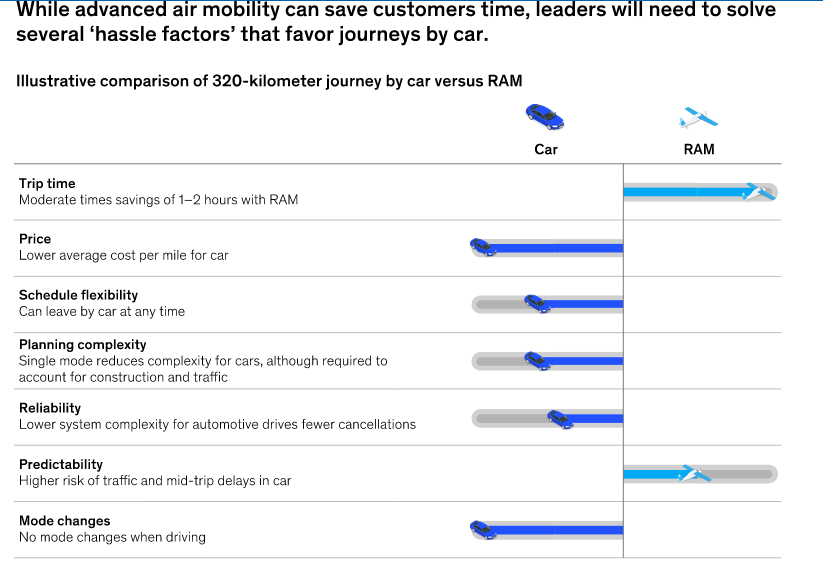Electric Aviation.
Becoming A Victim of Hype?
McKinsey just came out with a glowing report on the future of “regional air mobility” that’s being made possible primarily via introduction of small electric aircraft.
Sounds wonderful. Intra-regional air transportation will be coming back, is the message. Not a lot of research on actual demand volume. Great assumptions, though.
But there’s a bigger story between the lines that airport planners need to consider before changing Master Plans to accommodate what’s been mostly unquestioned hype about RAM and AAM modalities.
Before we start, let’s look back. Aviation has been here before. There have been a couple of past concepts that were absolutely guaranteed to fundamentally change aviation. Not many folks questioned the dogma of their huge future success.
A Sure Thing: Four Seat Jets For $850K. Anybody remember the concept of the “very light jet?” Lots of excitement. Really disruptive stuff. It was a genre of 4-6 seat aircraft where new manufacturing systems could deliver them for under a million dollars. Compared to existing turboprops priced at least four times that much, these VLJs would revolutionize general aviation.
 There was the Eclipse Jet. There was Adam Aircraft. We worked at various project levels involving both of these companies. Exciting. There were new uses of carbon fiber. New manufacturing techniques like “stir welding” and other magic. Big name billionaires were involved. Hundreds of sales were predicted.
There was the Eclipse Jet. There was Adam Aircraft. We worked at various project levels involving both of these companies. Exciting. There were new uses of carbon fiber. New manufacturing techniques like “stir welding” and other magic. Big name billionaires were involved. Hundreds of sales were predicted.
Oops. The one major advantage of these machines was price. And as things progressed prices went up to the point of erasing most of the demand for these VLJs. The glowing me-too predictions were empty air. No telling if the billionaires got financially hosed.
Huge Volume Concentrated On One Airplane. Remember the Airbus A380? The concept was that a 500-seat airliner was a future slam-dunk. There were glowing stories about how it would change air transportation, including throw-away assertions in places like the Wall Street Journal that all major airlines would be ordering the super-jumbo.
In the mid-1990s, large airports were modifying long-term facility plans to accommodate the certain inclusion of hundreds of these behemoths into global fleets.
And here we are today. A great airplane but dismal demand. The special gates and ramps and taxiways modified for  A380s weren’t needed.
A380s weren’t needed.
Missed in the game plan were issues like airport facilities, changes in consumer trends, and the low diversity of mission capability for an airliner that large. It was all ignored in the enthusiasm of seeing a big new airplane.
Lesson: When it comes to the projections of thousands of electric aircraft, airport planning will need a lot more data before investing big dollars into AAM-related operations.
In particular, it was two things that took down the circus tent for these supposed sure-thing aviation miracles.
One was completely misjudging the market role and market need. The second was raw costs. The financial investment didn’t make as much sense as the (unquestioned) hype promised.
Anybody see the similarities with electric air taxis and small airliners?
AAM & RAM. Following The Same Path? Okay, let’s move to today, and consider the concepts of “regional air mobility” and “advanced air mobility.” Very exciting. In some cases, even the most enthusiastic proponents of these concepts have missed several huge corollary leaps in enhancing efficiency of existing aviation infrastructure.
But Don’t Ask Questions. Increasingly, however, any factors, issues or questions that may throw a bit of rain on this parade are not just ignored, but even misconstrued to be advantages. McKinsey’s glowing article on the wondrous future of regional air mobility unfortunately is in that genre.
They included the following illustration, ostensibly as support for the concept. Actually, it does the opposite. Consider these “hassle factors”and ask if they represent just “factors” or “reality.”
Please note that cost comparisons are not considered in this analysis. That might be a critical issue, at least in this world, but ignored here. That is a theme that could be the quicksand under these rosy projections.
Nevertheless, McKinsey has accurately isolated these factors. But they are not “hassle factors” that can be addressed. Take a look.
Every one of these dynamics where a car is shown to have the advantage are concrete factors that can’t be changed. How about “schedule flexibility.” This is intrinsic to the fact that an air trip cannot be as time-flexible as a road trip. Therefore the limited travel options of air can result in that modality unable to compete on a total travel time basis.
Price? Cost of providing this RAM concept. Somebody please come to the surface on this one. The manufacturers of these air taxis, much less McKinsey, have no hard projections of what the ticket prices will be. We do have the recent data from Tecnam, which indicated that battery costs would result in astronomical operating costs.
Actually, what I read from this is that the concept is vastly inferior to current ground transportation. (It also assumes without any support that there is huge latent demand for air service between points 150 miles and less apart. Facts not in evidence, by the way.)
Clearly, the illustration says that RAM isn’t consumer-superior to other modes. The entire foundation of the McKinsey article says the opposite, and they are not alone in this mindset.
Not Allowed: Questions About Battery Supply & Environmental Damage. And, as with the entire electric aircraft concept, nobody – and we do mean nobody – dares bring up the battery issue.
I will – again.
What will be the supply chains? Will China continue to control the industry? What increases will there be in costs of lithium, cobalt and nickel when (if?) current mining processes are transformed away from being environmental  disasters often manned by near-slave labor. How about post-use disposal of these devices?
disasters often manned by near-slave labor. How about post-use disposal of these devices?
In light of these unknowns, nobody can predict the operational costs. We do know that one potential manufacturer, Tecnam, has pulled the plug on their program. We do know that NASA’s X-57 aircraft – apparently ready to go – has been cancelled due to what NASA described as safety issues.
Amid all the sunshine stories, these tough questions are never addressed. Pesky things that spoil the narrative, apparently.
Kick Out The Flower Children. Bring In Research Looking For Better Technology. Here’s the point. The entire AAM concept has been hijacked by dreamers, environmental jihadists without a clue, large corporations expecting a bonanza, and unfortunately by wishful-thinking “conclusions-before-data” research.
That was the M.O. with the VLJ and A380. It starts with the rosy conclusions and assumes that reality will bend to accommodate them. Plus, most of the media – including the aviation media – tend to get stuck in a loop that precludes any hard questions and becomes a race to produce the next sunshine story. Think not? Do a search and you’ll be hard pressed to find stories where any tough questions are posed.
This is not to imply there are not huge potential benefits, at least on paper.
But unless these issues are addressed, in ten years we may be looking back at AAM as being like the VLJ fiasco, except the economic wreckage will be geometric dimensions larger.
Think about it.
_____________
FAA-Re-Authorization Seminar
Now At Aviation Unscripted
A reminder that an in-depth and no-holds-barred review of proposed FAA Re-Authorization bills is now posted at our video channel, Aviation Unscripted.
 It is important that leaders in aviation question and analyze what Congress – populated by politicians, not aviation experts – are intending to impose on the industry. Simply being good followers leaves a vacuum that should not be filled by Congressional wish lists.
It is important that leaders in aviation question and analyze what Congress – populated by politicians, not aviation experts – are intending to impose on the industry. Simply being good followers leaves a vacuum that should not be filled by Congressional wish lists.
Bill Swelbar and I put it all out in the open. There are some parts of these bills that are outright useless and in some cases damaging to the future of aviation.
It is not a veneer pass, but an independent analysis with hard conclusions and firm suggestions that aviation leaders must consider.
Click here to access the video. Then hit the contact button and let loose with your thoughts and conclusions.
Take a stand. Letting Congress go unquestioned isn’t good business sense.
_________
